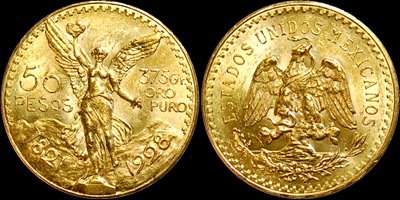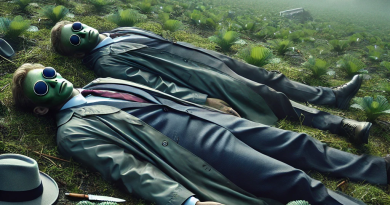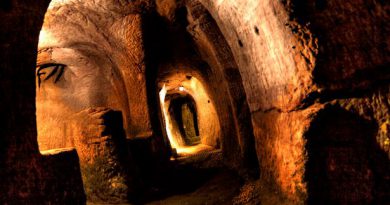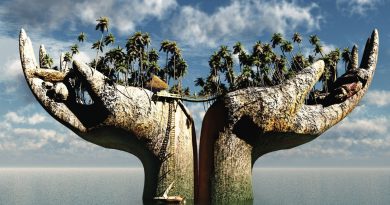Unexplained Mysteries – The Search for Gold at Victorio Peak
The Victorio Peak Treasure is one of the most famous treasures in the United States, second only perhaps to the Lost Dutchman Mine. In November 1937, a deer hunter and former medicine showman known as Doc Noss went searching for fresh water near the peak and discovered the hidden entrance to a tunnel. An old ladder lead into a maze of tunnels around a large cavern containing an old chest inscribed with the words “Sealed Silver” in Old English.
Doc Noss was born in Oklahoma and traveled all over the Southwest seeking excitement. In 1933, he married Ova “Babe Beckworth and the two settled down in Hot Springs, New Mexico, which later changed its name to Truth or Consequences. In November 1937, Doc, Babe, and four others left on a deer hunt into the Hembrillo Basin. Setting up camp on the desert floor at the base of Victoria Peak, the men headed into the wilderness, while their wives stayed at camp. Hunting by himself, Doc scouted the base of the mountain. When it began to rain, Doc sought shelter under a rocky overhang near the summit of the mountain. While waiting for the rain to subside he noticed a stone that looked as if it had been “worked in some fashion. Reaching down, he was unable to budge it, but after digging around the rock, he got his hands under it. Lifting the rock, he found a hole that lead straight down into the mountain.
November 1937, Doc, Babe, and four others left on a deer hunt into the Hembrillo Basin. Setting up camp on the desert floor at the base of Victorio Peak, the men headed into the wilderness, while their wives stayed at camp. Hunting by himself, Doc scouted the base of the mountain. When it began to rain, Doc sought shelter under a rocky overhang near the summit of the mountain. While waiting for the rain to subside he noticed a stone that looked as if it had been worked in some fashion. Reaching down, he was unable to budge it, but after digging around the rock, he got his hands under it. Lifting the rock, he found a hole that lead straight down into the mountain.
Peering into the darkness, Doc saw an old man-made shaft with a thick, wooden pole attached at one side. Doc thought that he had discovered an old abandoned mineshaft. When the rain finally stopped, Doc returned to camp, telling Babe of the discovery. The two decided to keep the discovery between themselves and return to the inspect the shaft later.
Within just a few days, Doc and Babe were back at the site with ropes and flashlights. Testing the old wooden pole attached to one side of the passage, Doc rejected the idea of using it dropped into the shaft with a rope instead. While Babe looked on from above, Doc inched his way down the narrow passageway into the mountain nearly sixty feet. Near the bottom, he encountered a huge boulder hanging from the ceiling, almost blocking his way.
Finally reaching the bottom, Doc stepped into a chamber the size of a small room. On the walls were drawings , some painted and others chiseled, that appeared to have been made by Indians. At one end of the chamber, the shaft continued downward. Once again, Doc began to descend, this time about 125 feet before the shaft again leveled off into a large natural cavern. Several smaller rooms had been chiseled from the rock along one wall. Stepping into the eerie darkness, Doc was alarmed when he saw a human skeleton, kneeling and securely tied to a stake driven into the ground. The skeletons hands were bound behind its back apparently, the person had been deliberately left there to die. Within moments he found more skeletons, most of them bound and secured to stakes like the first. Exploring further he found yet even more skeletons stacked in a small enclosure, much like a burial chamber. All told, he reportedly found twenty-seven human skeletons in the caverns of the mountain.
The treasure of Victioro Peak would not get to rest and wait for the Noss family. Airman First Class Thomas Berlett and a group of off-duty soldiers stumbled on a back door entrance to the cave and the treasure within it. Berlett reported his find, but he was denied permission to explore further. He later returned on his own and dynamited the new entrance in four places to conceal it. This was apparently of little good. By time Babe Noss acquired her injunction to stop the Army from excavating the site in 1961, the site had already been heavily excavated throughout and unconfirmed rumors claimed that the military had cleared out everything of value. In fact, the Army had petitioned the state for mineral rights, but they were denied possibly due to the Noss’s earlier claim. After public pressure, a highly publicized 10-day excavation with Babe Noss present as an observer further excavated the peak, but nothing was found but an Army signiture written within a buried chamber. Lambert Dolphin from the Stanford Research Institute used sonar to detect a greater chamber still in existence around 300 to 400 feet deep where Doc Noss said it was. Whether anything is left there for the Noss family to claim is unrevealed.
Doc’s wife, Ova “Babe” Beckwith, meanwhile tried to obtain legal ownership of Victorio Peak and acquired a lease with the state of New Mexico to excavate in the land. This paperwork provided the Noss family’s legal claim to the property. Doc took out around 200 gold bars and hid them from his family in various locations. It was illegal at the time to own gold not in the form of jewelry.
In the fall of 1939, Doc hired a mining engineer to widen the opening to the treasure, but he grossly underestimate the power of the blast and the fragile nature of the shaft and unwittingly closed it off to himself. With only a few gold bars to draw from, Noss tried to raise the funds to reopen his claim, trying to sell the bars on the black market. In 1948, he entered into a partnership with Charlie Ryan but soon feared Ryan would double cross him. Doc and a friend named Tony Jolly hid the gold in a new hiding place. Ryan retaliated by shooting Doc Noss, murdering him on March 5, 1949.
Victorio Peak is a high rocky outcropping in the Hebrillo Basin in southern New Mexico, surrounded by inhospitable enviroment near Hot Springs, New Mexico. The peak is riddled with a network of tunnels. Parts of the treasure were described as gold, silver, jewels and as many as 16,000 gold bars estimated around $1.7 billion dollars. Seventy-nine skeletons were described in an adjacent cavern.
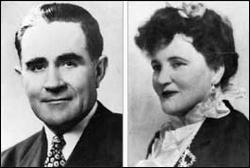
Victorio Peak, a craggy outcropping of rock barely five hundred feet tall, lies in the center of a dry desert lake known as the Hembrillo Basin. Beyond the Hembrillo Basin is a hundred mile stretch of desert known as the Jornada del Muerto. Victorio Peak, located in northern Dona Ana County, now lies within the White Sands Missile Range in south central New Mexico. However, long before Victorio Peak was encompassed by the government, a man by the name of Milton Ernest “Doc Noss spent some time exploring Victorio Peak while on a deer hunt.
The origin of the treasure is unrevealed. It’s believed it could be the lost treasure of Juan de Onate, the man who founded New Mexico as a Spanish colony. Another theory is that it belonged to a Catholic missionary named Father LaRue who once operated gold mines in the area. It’s also been linked to Maximillian, the Emperor of Mexico, and to the Apache Indians who raided stagecoaches heading to California.
Doc filled his pockets with gold coins, grabbed a couple of jeweled swords, and laboriously returned to Babe waiting anxiously at the surface. After telling her of what he had seen and showing her the loot, she insisted he go back into the mine for one of the iron bars. After much searching, he finally found a small iron bar that he could carry back through the narrow passageway. When he reached the surface, he told Babe, “This is the last one of them babies Im gonna bring out.” However, when Babe rolled the bar over, she noticed a yellow gleam where the gravel of the hillside had scratched off centuries of black grime. What looked to be a piece of iron was actually a solid gold bar.
After the discovery of the treasure, Doc and Babe spent every free moment exploring the tunnels inside the mountain, living in a tent at the base of the peak. On each trip, Doc would retrieve two gold bars and as many artifacts as he could carry. At one time, he brought out a crown, which contained two hundred forty-three diamonds and one pigeon-blood ruby. Yet, Doc trusted no one, not even his Babe, disappearing into the desert, hiding pieces of the treasure in places that he never revealed.
Among the artifacts, Doc is reported to have retrieved were documents dated 1797, which he buried in the desert in a Wells Fargo chest along with various other treasures. Although the originals have never been recovered, a copy of one of the documents proved to be a translation from Pope Pius III. Doc Noss cared little about the historical value of the treasures inside Victorio Peak, mostly ignoring the pouches, packs and artifacts, while he concentrated on the gold coins and bars. However, Doc was unable to capitalize on the gold bars, as four years before his discovery; Congress had passed the Gold Act, which outlawed the private ownership of gold. Unable to sell the gold bars on the open market, Noss was stymied, but continued to work steadily to remove the treasure.
In the spring of 1938, Doc Noss and Babe went to Santa Fe to establish legal ownership of the find, filing a lease with the State of New Mexico for the entire section of land surrounding Victorio Peak. Subsequently, he also filed several mining claims on and around Victorio Peak, as well as a treasure trove claim. With legal ownership established, Noss began to openly work the claim, but he also became increasingly paranoid, hiding the gold bars all over the desert.
When Docs story eventually hit the headlines, scholars began speculating on how the enormous treasure could have come to be stashed inside Victorio Peak. Some believe that Doc Noss found the Casa del Cueva de Oro, Spanish for the House of the Golden Cave. Others believe that Noss found the treasure of Don Juan de Onate, who, in 1598, founded New Mexico as a Spanish colony. Seeking out the Seven Cities of Gold, Onate was said to have been a cruel man, brutally subjugating the Indians to do his bidding by beating and torturing them. Reportedly, he amassed a treasure of gold, silver and jewels before being ordered back to Mexico City in 1607.
Others speculate that the treasure could be the missing wealth of Emperor Maxmillian, who served as Mexicos emperor in the 1860s. When Maxmillian heard of plot to assassinate him, he began to move his gold and treasures out of Mexico. Legend says he sent a palace full of valuables to the United States to be hidden. Maxmillian was assassinated in 1867. Finally, others believe that the treasures were hidden by Chief Victorio, for whom the peak is named. Victorio used the entire Hembrillo Basin as his stronghold, refusing to live on the San Carlos Reservation in Arizona where the government wanted to banish him. A treaty was reached between the tribe and the Federal government in Washington that the Indians could stay upon the land in New Mexico. However, with the discovery of gold, the treaty was broken in 1878 and Victorio went on the warpath.
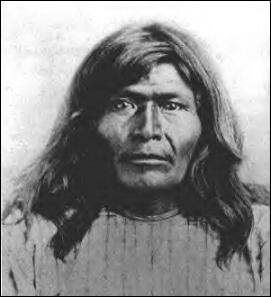
Continue reading on http://www.legendsofamerica.com/nm-treasures6.html
